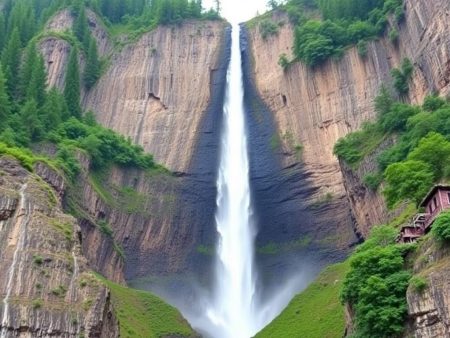S'élevant au-dessus des nuages et captivant l'imagination des aventuriers, la plus haute montagne du monde est depuis longtemps un symbole de la grandeur de la nature. Sa taille et sa majesté ont inspiré d'innombrables explorateurs à tester leurs limites, tandis que d'autres s'émerveillent simplement de sa beauté à couper le souffle de loin. Mais ce qui rend cette montagne si extraordinaire n'est pas seulement sa hauteur, ce sont les histoires, les défis et les
Découvrez la plus haute montagne du monde : faits, concurrents et mesures
S'élevant au-dessus des nuages et captivant l'imagination des aventuriers, la plus haute montagne du monde est depuis longtemps un symbole de la grandeur de la nature. Sa taille et sa majesté ont inspiré d'innombrables explorateurs à repousser leurs limites, tandis que d'autres s'émerveillent simplement de sa beauté à couper le souffle de loin. Mais ce qui rend cette montagne si extraordinaire n'est pas seulement sa hauteur, ce sont les histoires, les défis et l'émerveillement qu'elle évoque.
Convertissez la hauteur des personnes, bâtiments, montagnes et monuments les plus grands en m, pieds et pouces pour comparer
0' 0" est égal à 0,0 cm ou 0,00 m.
Si la plupart des gens pensent immédiatement au mont Everest, le concept de « plus haute montagne » n’est pas aussi simple qu’il y paraît. Selon la façon dont on le mesure, plusieurs prétendants au titre existent. Qu’il s’agisse de son altitude vertigineuse au-dessus du niveau de la mer ou de sa distance vertigineuse par rapport au noyau terrestre, chaque perspective offre une façon unique d’observer ces géants naturels. Alors, qu’est-ce qui définit vraiment la plus haute montagne ? Explorons le monde fascinant des sommets imposants et découvrons leurs secrets.
Définition de la plus haute montagne du monde
Pour déterminer la plus haute montagne, il faut savoir comment la « plus haute » est mesurée. Les montagnes sont évaluées en fonction de leur altitude au-dessus du niveau de la mer, de leur hauteur de la base au sommet ou de leur distance par rapport au noyau terrestre.
Comprendre les méthodes de mesure
Les méthodes de mesure varient en fonction du point de référence utilisé. L'altitude au-dessus du niveau de la mer mesure la hauteur du sommet d'une montagne par rapport au niveau moyen mondial de la mer. Cette méthode désigne le mont Everest comme le plus haut avec 8 848,86 mètres (29 031,7 pieds). La hauteur de la base au sommet calcule l'élévation verticale de la base d'une montagne à son sommet. Par exemple, le Mauna Kea à Hawaï a une hauteur totale de plus de 10 210 mètres (33 500 pieds) lorsqu'elle est mesurée à partir de sa base océanique. Enfin, la distance au noyau terrestre prend en compte la forme aplatie de la Terre, ce qui donne au Chimborazo en Équateur la plus grande mesure du noyau au sommet avec 6 384 kilomètres.
Comparaison de l'élévation maximale et de la hauteur de la base au sommet
L'altitude maximale se concentre strictement sur l'altitude, privilégiant le mont Everest pour son sommet imposant au-dessus de tous les autres. En revanche, la hauteur de la base au sommet met en valeur les montagnes submergées ou moins visibles, comme le Mauna Kea, qui s'élève à 4 205 mètres (13 796 pieds) au-dessus du niveau de la mer mais s'étend bien en dessous de la surface de l'eau. Ces distinctions révèlent comment la perspective modifie le titre de « plus haute montagne ».
Mont Everest : le détenteur officiel du titre
Le mont Everest, culminant à 8 848,86 mètres au-dessus du niveau de la mer, est la plus haute montagne du monde en termes d'altitude. Situé dans la chaîne de l'Himalaya, à la frontière entre le Népal et le Tibet, il est un symbole de merveille naturelle et d'ambition humaine.
Formation et caractéristiques géologiques
Le mont Everest, qui fait partie de l'Himalaya, s'est formé il y a environ 60 millions d'années suite à la collision des plaques tectoniques indienne et eurasienne. Cette activité tectonique continue de soulever la montagne de 4 millimètres par an.
Son sommet est constitué d'un mélange de roches sédimentaires et métamorphiques, notamment de calcaire et de marbre, avec des couches exposées de schiste et de quartzite. Des conditions difficiles et des vents dépassant les 320 km/h dominent les régions supérieures. Le système glaciaire de la montagne comprend le célèbre glacier Khumbu, qui constitue l'approche du camp de base du côté népalais.
Histoire de l'exploration et de l'escalade
La première ascension confirmée de l'Everest a eu lieu le 29 mai 1953, lorsque Sir Edmund Hillary de Nouvelle-Zélande et Tenzing Norgay, un sherpa népalais, ont atteint le sommet. Leur expédition a marqué un tournant dans l'histoire de l'alpinisme.
Les alpinistes d'aujourd'hui sont confrontés à des défis extrêmes, notamment le mal des montagnes, des températures négatives et des avalanches. Malgré ces risques, plus de 6 000 personnes ont atteint le sommet, et les expéditions guidées commerciales sont de plus en plus courantes. Les itinéraires clés comprennent le col Sud au Népal et l'arête Nord au Tibet.
Autres prétendants au titre
Pour déterminer la plus haute montagne, d'autres critères permettent de prendre en compte d'autres sommets. Parmi ceux-ci figurent le Mauna Kea et le Chimborazo, des montagnes dont la hauteur est unique en raison de mesures distinctes.
Mauna Kea : le géant sous-marin
Le Mauna Kea, situé à Hawaï, présente une hauteur vertigineuse lorsqu'elle est mesurée à partir de sa base sur le fond marin. Bien que son sommet atteigne 4 205 mètres au-dessus du niveau de la mer, la montagne s'étend sur plus de 10 210 mètres de sa base à son sommet, surpassant le mont Everest en termes de distance verticale. La base submergée de ce volcan endormi montre comment l'évaluation des mesures sous-marines révèle des dimensions qui ne sont pas souvent prises en compte pour les sommets traditionnels.
Chimborazo : au plus près des étoiles
Le Chimborazo, un stratovolcan situé en Équateur, est le point le plus proche de l'espace sur Terre lorsqu'il est mesuré à partir du noyau de la planète. Son sommet se situe à 6 263 mètres au-dessus du niveau de la mer, mais en raison du renflement équatorial de la Terre, le pic du Chimborazo s'étend à environ 6 384 kilomètres du noyau, surpassant ainsi le mont Everest. Cette mesure souligne l'influence de la forme de la Terre sur la perception de la hauteur des montagnes.
La science derrière la mesure des montagnes
Déterminer la plus haute montagne nécessite des méthodologies précises et une technologie en constante évolution. Des outils avancés et des techniques raffinées garantissent des mesures précises, mais des défis subsistent en raison de facteurs environnementaux et géologiques.
Progrès technologiques en matière de mesure
La technologie moderne a révolutionné la mesure des montagnes. Les systèmes satellitaires comme le GPS offrent une précision centimétrique, en utilisant les signaux des réseaux mondiaux de navigation pour calculer la position du sommet d'une montagne par rapport au niveau de la mer. Les technologies radar et lidar permettent une cartographie topographique détaillée en émettant des ondes électromagnétiques ou des lasers pour mesurer les élévations de surface. En 2020, la Chine et le Népal ont conjointement révisé la hauteur du mont Everest à 29 031,7 pieds (8 848,86 mètres) à l'aide du GPS et d'un radar à pénétration de sol. Les progrès de la gravimétrie et des données sismiques affinent également les mesures en détectant les variations de la force gravitationnelle et de la densité du sous-sol.
Les défis de la détermination des hauteurs
Les facteurs environnementaux et géologiques compliquent les mesures d'altitude. L'activité géologique dynamique, comme le mouvement des plaques tectoniques, peut modifier les altitudes au fil du temps, ce qui nécessite une réévaluation périodique. La forme irrégulière de la Terre signifie que le niveau de la mer n'est pas uniforme à l'échelle mondiale, ce qui introduit des divergences dans les points de référence. Les conditions météorologiques extrêmes, comme les vents violents et les basses températures sur les sommets, compliquent les relevés sur site. Les erreurs humaines et les limites de l'équipement peuvent également affecter la précision, en particulier sur les sommets éloignés ou inaccessibles.
L'importance culturelle et environnementale
Les montagnes, en particulier celles qui se disputent le titre de plus haute montagne, revêtent une importance culturelle et environnementale profonde. Elles influencent les traditions, attirent l’attention du monde entier et servent d’indicateurs de la santé environnementale.
Contes et traditions associés aux montagnes
Les montagnes comme le mont Everest, le Mauna Kea et le Chimborazo sont profondément ancrées dans les récits culturels. L'Everest, connu sous le nom de « Sagarmatha » au Népal et de « Chomolungma » au Tibet, est vénéré comme une entité sacrée. Les communautés sherpas locales le considèrent comme la déesse du ciel et l'intègrent dans leurs pratiques et rituels spirituels. Des cérémonies saisonnières, telles que pujas pratiquées par les grimpeurs, honorez ces croyances avant les expéditions.
À Hawaï, le Mauna Kea, surnommé « la montagne blanche », revêt une importance culturelle pour les autochtones hawaïens. Il est considéré comme un lien entre le ciel et la terre, ce qui souligne son importance dans la mythologie et l'astronomie. Le Chimborazo est également vénéré par les communautés andines d'Équateur, où les légendes locales décrivent souvent son sommet comme une divinité protégeant les peuples et la terre.
Préserver les plus hauts sommets du monde
Les montagnes d’importance mondiale sont confrontées à des menaces croissantes, notamment l’essor du tourisme, le changement climatique et la pollution. L’Everest, par exemple, connaît une accumulation importante de déchets en raison de l’activité d’escalade intense, ce qui a incité le Népal et la Chine à lancer des initiatives de nettoyage. La politique « Carry Your Trash » vise à réduire l’empreinte environnementale causée par les expéditions.
Le changement climatique a des répercussions sur les glaciers et les écosystèmes de ces sommets. Le réchauffement climatique entraîne la fonte des glaces, déstabilisant les voies d’escalade et modifiant les sources d’eau essentielles pour les communautés voisines. Des organisations comme le Centre international de développement intégré des montagnes (ICIMOD) se concentrent sur l’étude de ces changements et la mise en œuvre de stratégies d’adaptation.
Les pratiques touristiques durables, les réglementations plus strictes et les efforts de collaboration internationale restent essentiels pour protéger ces monuments imposants pour les générations futures.
Conclusion
Des montagnes comme l'Everest, le Mauna Kea et le Chimborazo captivent l'imagination, chacune offrant des perspectives uniques sur ce que signifie être le plus grand. Au-delà de leurs hauteurs impressionnantes, ces sommets symbolisent l'aventure, la résilience et l'équilibre délicat entre l'ambition humaine et la grandeur de la nature.
À mesure que la technologie progresse et que notre compréhension de ces géants s'approfondit, ils continuent d'inspirer l'admiration et d'exiger le respect. Qu'ils soient admirés pour leur importance culturelle, leurs merveilles géologiques ou leur beauté à couper le souffle, ces monuments imposants nous rappellent l'importance de préserver leur héritage pour les générations futures.
Questions fréquemment posées
Quelle est la plus haute montagne du monde ?
Le mont Everest est considéré comme la plus haute montagne du monde, avec une hauteur officielle de 29 031,7 pieds (8 848,86 mètres) au-dessus du niveau de la mer.
Comment le mont Everest s'est-il formé ?
Le mont Everest s'est formé il y a environ 60 millions d'années à la suite de la collision des plaques tectoniques indienne et eurasienne, qui a provoqué l'élévation de la chaîne de montagnes de l'Himalaya.
Y a-t-il d’autres prétendants au titre de la plus haute montagne ?
Oui, le Mauna Kea à Hawaï est plus haut que l'Everest lorsqu'il est mesuré à partir de sa base océanique, et le Chimborazo en Équateur a la plus grande distance par rapport au noyau terrestre en raison du renflement équatorial de la planète.
À quels défis les alpinistes sont-ils confrontés sur le mont Everest ?
Les grimpeurs sont confrontés à des défis extrêmes tels que des températures glaciales, des vents violents, de faibles niveaux d'oxygène et le risque d'avalanches, ce qui en fait une ascension dangereuse mais enrichissante.
Qui a été le premier à gravir le mont Everest ?
Sir Edmund Hillary et Tenzing Norgay furent les premiers alpinistes à atteindre avec succès le sommet du mont Everest le 29 mai 1953.
Comment mesure-t-on la hauteur des montagnes ?
La hauteur des montagnes est généralement mesurée à partir du niveau de la mer à l'aide de technologies modernes telles que le GPS, le radar et le lidar pour des résultats précis et exacts, comme le montre la révision de 2020 de la hauteur de l'Everest.
Pourquoi le Mauna Kea n’est-il pas reconnu comme la plus haute montagne ?
Le Mauna Kea mesure plus de 10 210 mètres (33 500 pieds) depuis sa base océanique, mais son sommet au-dessus du niveau de la mer n'est que de 4 205 mètres (13 796 pieds), ce qui est bien plus bas que l'Everest.
Qu'est-ce qui rend le Chimborazo unique par rapport aux autres hautes montagnes ?
Le pic du Chimborazo est le point le plus éloigné du noyau terrestre en raison du renflement équatorial, ce qui en fait la montagne la plus proche de l'espace.
Quels problèmes environnementaux affectent le mont Everest ?
Le mont Everest est confronté à des défis tels que le changement climatique, la fonte des glaciers et l'accumulation de déchets provenant des expéditions d'escalade, ce qui incite à des initiatives de nettoyage et à des efforts de tourisme durable.
Pourquoi le mont Everest est-il important sur le plan culturel ?
Le mont Everest est sacré pour les communautés locales, connu sous le nom de « Sagarmatha » au Népal et « Chomolungma » au Tibet, symbolisant la connexion spirituelle et l'héritage culturel.
L’ascension du mont Everest est-elle toujours populaire ?
Oui, l'ascension de l'Everest reste populaire, avec plus de 6 000 personnes ayant atteint le sommet. Des expéditions commerciales rendent l'ascension accessible, même si elle reste très difficile.
Comment la technologie a-t-elle amélioré la mesure des montagnes ?
Les avancées telles que les technologies GPS, radar et lidar offrent une précision au centimètre près, aidant à affiner les mesures et à surmonter les défis environnementaux et logistiques.
Que peut-on faire pour protéger le mont Everest ?
Promouvoir un tourisme durable, appliquer les règles de gestion des déchets et lutter contre les impacts du changement climatique sont essentiels pour préserver l’Everest et son écosystème pour les générations futures.





